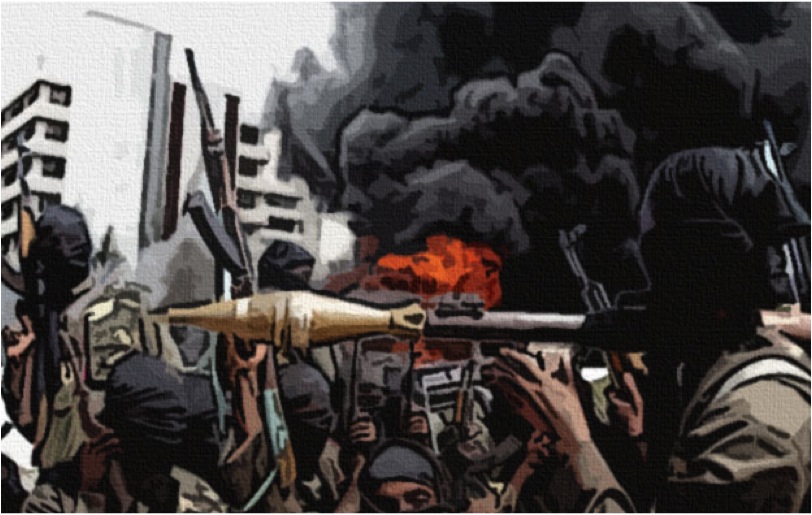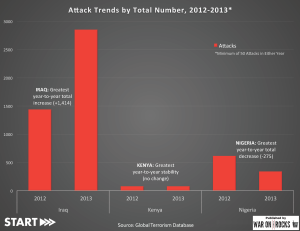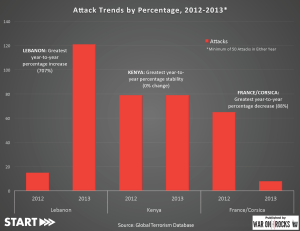Infographic: Country-Specific Trends in Terrorism, 2012-2013

Editor’s note: We’ve partnered with the National Consortium for the Study of Terrorism and Responses to Terrorism (START) to publish a series of infographics based on data from their Global Terrorism Database and related START projects. Each week we’ll release a new set of graphics that depict trends in global terrorism activity. Sign up for the War on the Rocks newsletter to make sure you don’t miss any of them!
Graphics designed by Michael Jensen, START.
Last week we published a global heat map that depicted the intensity and concentration of terrorist violence in 2013. This week, we look at those countries that saw the greatest increase, greatest decrease, and most stability in levels of terrorism between 2012 and 2013. The graphics are again produced by START and are based on data from their Global Terrorism Database.
The first chart depicts trends based on raw numbers.

But the picture changes when we look at percentages rather than total change.

So we can see that Iraq experienced the largest jump in terrorist incidents between the two years. And although the increase of 1,414 represented a leap of approximately 100%, this was far from the largest percentage gain. That distinction goes to Lebanon, which saw the number of terrorist incidents grow by more than 700%. Similarly, the largest decrease in real terms occurred in Nigeria, whereas the biggest percentage drop was in France/Corsica. Kenya saw the exact same number of attacks in both years, so of course appears in both graphics.
So what can we learn from these charts? First, it shows that the method in which data is modeled can yield different pictures, so it’s important to bear that in mind. Nevertheless, whether year-over-year change is examined in real numbers or percentage terms, the data can be used to either validate or challenge our assumptions that are based on empirical observation and media reporting. So for instance:
- The Iraq figures are not surprising, especially in light of recent events. According to the UN, 2013 was the country’s deadliest year since 2008.
- Nigeria’s decrease, while important, does not appear to be a sign that things have improved considerably. 2013 was still a very bad year, as the country witnessed more than 300 attacks and more than 2000 terrorism-related fatalities. Early indicators suggest that 2014 may be even worse than 2013. The decrease in 2013 was likely driven in part by reinvigorated CT efforts, rather than being reflective of a scaling back of ambitions on the part of Boko Haram.
- In Lebanon, the increase is driven almost entirely by spillover from the ongoing war in Syria. The border areas of Lebanon, in particular, have become a virtual extension of the Syrian battlefield.
- The decrease in France/Corsica is illuminating, mainly because the current paradigm through which most of us view terrorism pays disproportionate attention to that which is motivated by the jihadist ideology, and less to groups like the Corsican National Liberation Front. That group was responsible for more than 50 non-lethal bombings of vacation homes and businesses in 2012, but did not commit a single attack in 2013.
- The fact that there was no change at all in attack numbers in Kenya between the two years suggests a certain enduring characteristic to the threat posed to that country by al-Shabaab, at least in one sense (though not necessarily in terms of scale).
**Notes:
This graphic is based on preliminary data that is subject to change. 2013 GTD data is not yet available for public download or distribution. It will be released via the GTD website later this summer.
Beginning with 2012 data collection, START made several important changes to the GTD collection methodology, improving the efficiency and comprehensiveness of the process. In general, comparisons of aggregate statistics over time and between locations should be interpreted with caution due to these methodological improvements, as well as the considerable variation in the availability of source materials.
Image credit: AK Rockefeller

